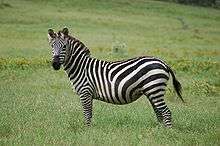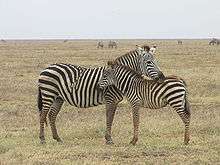Grant's zebra
Grant's zebra (Equus quagga boehmi) is the smallest of the seven subspecies of the plains zebra. This subspecies represents the zebra form of the Serengeti-Mara ecosystem.
| Grant's zebra | |
|---|---|
 | |
| At the Hell's Gate National Park, Kenya | |
| Scientific classification | |
| Kingdom: | Animalia |
| Phylum: | Chordata |
| Class: | Mammalia |
| Order: | Perissodactyla |
| Family: | Equidae |
| Genus: | Equus |
| Species: | |
| Subspecies: | E. q. boehmi |
| Trinomial name | |
| Equus quagga boehmi Matschie, 1892 | |
| Synonyms | |
|
Equus quagga zambeziensis | |
Distribution
The distribution of this subspecies is in Zambia west of the Luangwa river and west to Kariba, Katanga Province of the Democratic Republic of the Congo, north to the Kibanzao Plateau, and in Tanzania north from Nyangaui and Kibwezi into southwestern Kenya as far as Sotik. It can also be found in eastern Kenya and east of the Great Rift Valley into southernmost Ethiopia. It also occurs as far as the Juba River in Somalia.
Upper Zambezi zebra
Duncan (1992)[1] recognized the Upper Zambezi zebra (Equus quagga zambeziensis Prazak, 1898[2]). Groves and Bell (2004)[3] came to the conclusion that the zebras from West Zambia and Malawi cannot be distinguished cranially and that they differ only slightly from other northern plains zebras. The rather minor size difference does not justify a separate subspecific status for the Upper Zambezi zebra. Therefore, they combine these zebras with Grant's zebra (Equus quagga boehmi).
Characteristics

This northern subspecies is vertically striped in front, horizontally on the back legs, and diagonally on the rump and hind flanks. Shadow stripes are absent or only poorly expressed. The stripes, as well as the inner spaces, are broad and well defined. Northerly specimens may lack a mane. Grant’s zebras grow to be about 120 to 140 cm (3.9 to 4.6 ft) tall, and generally weigh about 300 kg (660 lb).[4] The zebras live in family groups of up to 18 zebras, and they are led by a single stallion.[5] Grant’s zebras typically live 20 years.
Regional extinctions
Recent civil wars in the Congo, Rwanda, Somalia, Sudan, Ethiopia, and Uganda have caused dramatic declines in all wildlife populations, including those of Grant’s zebra. It is now extinct in Burundi. Civil war in Angola during much of the past 25 years has devastated its wildlife populations, including its once-abundant plains zebra, and destroyed the national parks administration and infrastructure. Consequently, Grant's zebra is probably extinct or nearly so in Angola, although confirmation will have to wait until future surveys are conducted.
More Grant’s zebras are in the wild than any other species or subspecies of zebras. Unlike Grevy and mountain zebras, they are not endangered.[6] Grant’s zebras eat the coarse grasses that grow on the African plains, and they are resistant to diseases that often kill cattle,[7] so the zebras do well in the African savannas. However, recent civil wars and political conflicts in the African countries near their habitats has caused regional extinction, and sometimes zebras are killed for their coats, or to eliminate competition with domestic livestock.[4]
Controversial Burchell's zebra introductions in Grant's zebra historical range
From 2001 until 2016 the Kissama Foundation reintroduced wildlife in the Kissama National Park of Angola. The project was dubbed Operation Noah's Arc.Amongst the animals such as blue wildebeest, Waterbuck, Cape giraffe, Bush elephants, Oryx Gemsbok, Livingstone eland, Nyala and Ostrich where also Burchells zebras. [8][9] And from 2017 until 2019 Wildlifevetsnamibia exported wildlife to the Democratic Republic of the Congo's capital city Kinshasa to introduce animals in Parc de la Vallée de la Nsele in partnership with Institut Congolais pour la Conservation de la Nature [10] Amongst the animals where Golden Oryx Gemsbok, Impala, Blue Wildebeest, Kafue Lechwe, Nyala, Blesbok, Red Hartebeest, Southern White Rhino, Angolan Giraffe, Bush elephants and Burchell's zebras. Both introductions in west Angola and west DRC are controversial since the park service bodies from both countries did not opt to buy the native Grant's Zebra from for example countries as Zambia, Tanzania or Kenya.
In northwest and northeast of Angola the Grant's zebra is extinct. But a small population remains in the DRC's Upemba National Park. The DRC has now two different subspecies populations.
Habitat
Zambia is pretty good and an ideal place for Zebras. These interesting animals prefer living in savanna woodlands and grasslands without trees. They cannot be found in deserts, wetlands, or rainforests. The mountain variety lives in rocky mountainous areas. Unfortunately, the availability of habitat for all zebras is shrinking, resulting in population decline.
Diet
Zebras are exclusively herbivorous, meaning that they only eat plants. Their diet is almost entirely made up of grasses, but they also eat leaves, bark, shrubs, and more. They spend most of their time grazing on grasses, and then regurgitating and re-chewing those grasses, called “cud.”
Behavior
Grant's Zebras like many other Zebras are highly social creatures and different species have different social structures. In some species, one stallion guards a harem of females, while other species remain in groups, but do not form strong social bonds. They can frequently change herd structure, and will change companions every few months.
Reproduction
Female zebras can have one calf per year. Their gestation period is around 360 – 395 days long, depending on the species. The mother will protect her calf, and it can stand, walk, and run shortly after birth. This is especially important, as calves are vulnerable to predators. Calves will nurse from their mother for up to one year before being weaned.
Gallery
 Mother and foal in Lakeland, Florida
Mother and foal in Lakeland, Florida.jpg) Near Chilanga, Zambia
Near Chilanga, Zambia
 Pregnant, Serengeti, Tanzania
Pregnant, Serengeti, Tanzania Grant's Zebra inside Ngorongoro Crater during the dry season.
Grant's Zebra inside Ngorongoro Crater during the dry season. Grant's zebra in the Ark Encounter's Ararat Ridge Petting Zoo
Grant's zebra in the Ark Encounter's Ararat Ridge Petting Zoo
References
- Duncan, P. (ed.). 1992.Zebras, Asses, and Horses: An Action Plan for the Conservation of Wild Equids. Gland, Switzerland: IUCN/SSC Equid Specialist Group.
- Mayer, T.; Kispal, I.; Cuisin, J.; Csorba, G. (2013). "Type series of Equus quagga zambeziensis (Mammalia: Perissodactyla: Equidae)". Annales historico-naturales Musei nationalis Hungarici. 105: 247–257.
- Groves, C.P. & Bell, H.B. 2004. "New Investigations on the Taxonomy of the Zebras Genus Equus, subgenus Hippotigris". Mammalian Biology. 69: 182-196.
- "ANIMAL BYTES - Grant's Zebra". SeaWorld/Busch Gardens ANIMALS. SeaWorld Parks & Entertainment. Archived from the original on September 13, 2011. Retrieved September 13, 2011.
- "The Zoo | Grant's zebra". www.belfastzoo.co.uk. Retrieved 2020-05-25.
- "Grant's Zebra". Honolulu Zoo. Archived from the original on September 13, 2011. Retrieved June 1, 2011.
- "The Zoo | Grant's zebra". www.belfastzoo.co.uk. Retrieved 2020-05-25.
- https://oxpeckers.org/2016/03/sa-breeders-buck-the-system-2/
- https://m.youtube.com/watch?v=101oYIGhiEc
- https://www.wildlifevetsnamibia.com/documentation.html
External links
- Moelman, P. D. 2002. Equids: Zebras, Asses and Horses. Status Survey and Conservation Action Plan. IUCN/SSC Equid Specialist Group.)

